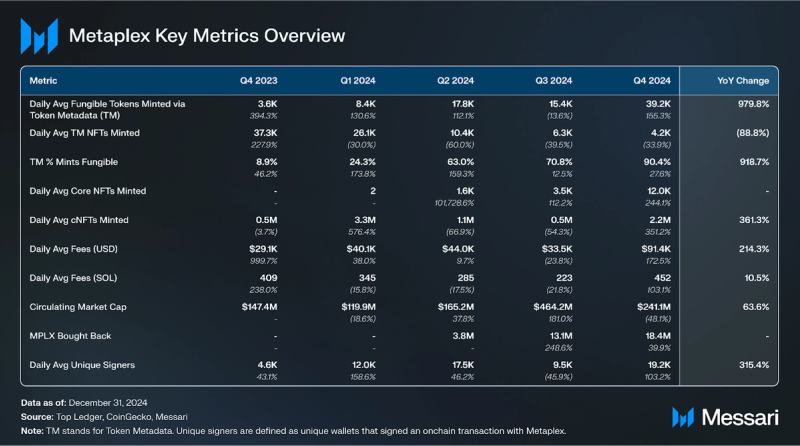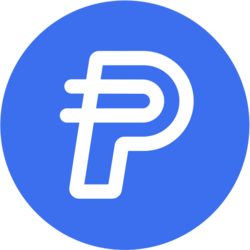Key Insights
- In Q4, the total number of fungible tokens minted with Metaplex surpassed 10 million as daily average fungible tokens minted via the Token Metadata program increased 155% QoQ from 15,400 to an all-time high of 39,200, a more than 10x year-over-year increase from 3,600 in the fourth quarter of 2023. This uptick was driven by Token Metadata powering the Q4 surge in memecoin activity on Solana.
- Daily average mints from Core, Metaplex’s most advanced NFT standard, increased 244% QoQ from 3,500 to an all-time high of 12,000, while daily average mints from Bubblegum, Metaplex’s compressed NFT (cNFT) program, increased 350% QoQ from 500,000 to 2.2 million.
- In Q4, a record 34,000 SOL (+13% QoQ) generated from protocol fees was spent buying back a record 18.4 million MPLX (+40% QoQ)
- In December, Metaplex launched public beta access for the Metaplex Aura Network, a data network for Solana and the Solana Virtual Machine (SVM). In February, Aura surpassed 150 million read requests and reached 99.9999% data consistency for compressed NFT proofs.
- In October, Metaplex released its Token Metadata (TM) optimization, which reduces the size of TM accounts, making Solana more efficient and cost-effective for its users. Thereafter, Metaplex released upgrade authority for the TM program to three security firms as it prepares TM to become the first immutable digital asset standard on Solana.
Primer
Metaplex (MPLX) is the leading digital asset protocol for Solana and the Solana Virtual Machine (SVM). The Metaplex Protocol is used to create and manage digital assets across a variety of industry verticals, including NFTs, memecoins,, RWAs, gaming, DePIN, and more. First launched in June 2021, Metaplex accounts for over 99% of NFT issuance on Solana and more than 90% of fungible token issuance on the network.
Metaplex’s Digital Asset Standard (DAS) is its standardized interoperable framework that establishes the necessary schemas, behaviors, and system architecture for various types of digital assets. Developers implement the DAS onchain via the Metaplex Program Library (MPL), which enables them to create and manage digital assets. Key components of the MPL include Metaplex Core (NFTs), Bubblegum (compressed NFTs), Token Metadata (data attachment for fungible and non-fungible tokens), and Candy Machine and Core Candy Machine (minting and distribution of NFT collections and Core assets). Metaplex’s Developer Platform provides a comprehensive suite of tools, software development kits (SDKs), and reference interfaces for effective use of the DAS and MPL.
In September 2024, Metaplex launched Aura, its data network for Solana and the SVM. With the introduction of Aura, Metaplex now provides a complete framework as the MPL can be used to write to Solana/the SVM by paying in SOL and Aura can be used to read data by paying in MPLX. As a distributed network, Aura removes the single points of failure inherent to alternative data indexing services.
The Metaplex protocol is governed by the Metaplex DAO, which is made up of MPLX tokenholders, and administered by the Metaplex Foundation, a non-profit organization dedicated to supporting and growing the Metaplex ecosystem. For a full primer on Metaplex, refer to our Initiation of Coverage report.
Website / X (Twitter) / Discord
Key Metrics
Protocol Analysis
Fungible and Non-Fungible Asset Creation

In Q4, mints from Metaplex’s three main programs for asset creation on Solana all increased by 100% or more QoQ. Daily average mints from Core, Metaplex’s most advanced NFT standard since its launch in March 2024, increased 244% QoQ from 3,500 to an all-time high of 12,000, while daily average mints from Bubblegum, Metaplex’s compressed NFT (cNFT) program, increased 350% QoQ from 500,000 to 2.2 million. Moreover, the week of Nov. 11, 2024, Core achieved weekly all-time high mints of 121,000, while Bubblegum mints reached an all-time high of 103.5 million the week of December 23, more than 20x the previous ATH from 2023.
Likewise, daily average mints from the Token Metadata program (used to attach metadata to fungible and non-fungible tokens) increased 100% QoQ from 21,700 to 43,200. On an annual basis, daily average mints from Token Metadata have increased by 5% from 40,100 in Q4 2023, while daily average mints from Bubblegum increased by 360% from 480,000.
Each of these programs has been designed to optimize asset creation and management for particular use cases.
- Core: In contrast to legacy NFT standards built on top of such as Solana Program Library (SPL) Token or Token extensions, which rely on multiple accounts, Metaplex core features a single account design. This architecture significantly reduces minting costs and improves the overall network load on Solana. For instance, minting an NFT with Metaplex Core is estimated to cost 0.0029 SOL, compared to 0.022 SOL using the Token Metadata program. Additionally, Metaplex Core features an advanced plugin library, a modular collection of features that either store data or provide additional functionality to the asset like built-in staking or asset-based point systems. The combination of Core’s single account design and the plugin library make it the most advanced NFT standard on Solana to date.
- Bubblegum: By using Merkle Trees and only storing the Merkle root and essential data onchain, Bubblegum significantly reduces the cost of onchain storage for NFTs, enabling devs and creators to scale NFT minting while minimizing costs. For instance, minting 1 billion uncompressed NFTs would cost ~12 million SOL, making large-scale NFT applications economically unfeasible. In contrast, minting 1 billion cNFTs through direct transactions costs as low as 5,000 SOL.
- Token Metadata: On Solana, Mint Accounts are responsible for storing a token’s global information, while token accounts store the relationship between a wallet and a Mint Account. The Token Metadata program uses Program Derived Addresses (PDAs) derived from the addresses of Mint Accounts to attach additional data to fungible and non-fungible tokens.

Daily average fungible tokens minted via the Token Metadata program increased 155% QoQ from 15,400 to an all-time high of 39,200, a more than 10x year-over-year increase from 3,600 in the fourth quarter of 2023. This growth reflects the increasing uptrend in memecoin and AI token activity. Token launchpads like Pump.fun and Meteora’s Mint as well as AI agent toolkits like Griffain and SendAI use the Token Metadata program to create fungible tokens.

In Q4, fungible tokens accounted for 90% of Token Metadata program mints, an increase of 28% QoQ from 70.8% in Q3. Fungible tokens first eclipsed non-fungible tokens in March 2024, to become the majority of weekly mints for the Token Metadata program. Since April 2024, this trend has continued to strengthen with an all-time high dominance of more than 95% of Token Metadata program mints being of fungible tokens the week of November 18, 2024, and more than 93% the last week of Q4. The increasing dominance of fungible token creation via the Token Metadata program can be attributed to memecoin and AI activity on Solana driving the creation of additional assets in those categories relative to TM non-fungible token creation. This is compounded by the fact that Core has largely replaced Token Metadata as the primary standard for NFTs on Solana. Non-fungible mints via TM are down 89% year-over-year from a daily average of 37,300 in Q4’23 to 4,200 in Q4’24, while daily average Core mints increased 244% QoQ to 12,000 in Q4.

Not only have fungible token mints via the Token Metadata program grown in absolute terms (daily avg up 10x YoY) and relative terms (now ~90% of Token Metadata mints), but they have also increased in dominance compared to fungible token mints on Ethereum and Layer 2’s. In 2024, more than 7.4 million fungible tokens were minted via the Token Metadata program, seven times more than the 1.06 million minted across Ethereum and its Layer 2s. Moreover, in the fourth quarter, the Token Metadata program had a record 12 times more fungible token mints than Ethereum and its Layer 2s (+210% QoQ). Ultimately, the dominance of Metaplex’s Token Metadata program for fungible token mints is a reflection of Solana’s dominance as the epicenter for onchain trading activity, and Metaplex’s position as the protocol used to create virtually all tokens on the network.

In 2024, Metaplex had over 705 million transactions, more than three times its prior lifetime total of 233 million dating back to June 2021. Moreover, on December 27, 2024, daily transactions hit an all-time high of more than 23 million, its sixth consecutive day reaching an all-time high after eclipsing the previous all-time high set on February 3, 2024. This spike in transactions was almost entirely driven by Bubblegum, with more than 103 million Bubblegum transactions the week of December 23, 2024. As a result, in Q4’24 Metaplex averaged 3.0 million daily transactions, an increase of 350% QoQ from 659,000 average daily transactions in Q3’24. This increase is approximately in line with the 330% year-over-year increase from 63.8 million average daily transactions in Q4’23.

Daily average unique signers (wallets that signed an onchain transaction with Metaplex), increased 103% QoQ from 9,500 to an all-time high of 19,200 in Q4. Additionally, Metaplex averaged 14,500 daily unique signers in 2024, a 330% increase from 3,300 average daily unique signers in 2023. Like with other metrics, much of the increase can be attributed to an increase in memecoin activity. Another contributing factor to the uptick has been an increase in Core mints, as each core mint requires a signing wallet. Since August monthly Core mints have increased 600% from 57,000 to more than 400,000 in December.
Financial

In the fourth quarter, MPLX’s circulating market cap declined 30% QoQ to $297 million. However, year-over-year, MPLX’s market cap is effectively flat, up 1% from $295 million at the close of Q4 2023. Regarding fees, Metaplex generated a record quarterly total in both USD and SOL. Specifically, 41,600 SOL in fees were generated in Q4, a 10% increase year-over-year from 37,700 SOL in Q4’23 and a 103% increase QoQ. In USD terms, $8.4 million was generated, a 214% increase year-over-year from $2.7 million in Q4’23 and a 172% increase QoQ.
All Metaplex protocol fees on Solana are paid in SOL and are listed below. Notably, fees on other networks are priced equivalently but charged in the native currency of each network (e.g., ETH on Eclipse, SOL on Sonic, etc.).
- Core: Create (0.0015 SOL), Execute (0.00004872 SOL)
- Token Metadata: Create (0.01 SOL)
- Bubblegum: Create (Free)
- MPL Hybrid: Swap (0.005 SOL)
- Fusion (Trifle): Swap (0.005), Combine (0.002), Split (0.002 SOL), Edit constraint (0.01 SOL)
Half of all fees generated on Solana are used to purchase MPLX which is subsequently contributed to the Metaplex DAO treasury. This is in stark contrast to many other protocols, which have to pay a large portion of fees to third parties such as liquidity providers, lenders, or validators and thus cannot afford to allocate such a high ratio to token buyback.

In the fourth quarter, a record 34,000 SOL (+13% QoQ) generated from protocol fees was spent buying back MPLX from the open market. This resulted in a record 18.4 million MPLX bought back in Q4 (+40% QoQ), while the price of MPLX declined from $0.42 to $0.30 (-42%) QoQ.
Specifically, from June to October 2024, Metaplex used 10,000 SOL in fees each month to buy back MPLX, while 12,000 SOL was used in both November and December 2024, and January 2025, and nearly 10,900 SOL was used in February 2025. This has resulted in the buyback of ~52.54 million MPLX (~5.25% of the total token supply), with ~9.2 million MPLX (0.92% of the total token supply) bought back in January, the largest monthly buyback to date.
Outside of buybacks, the MPLX token has a number of functions within the Metaplex protocol:
- Governance: MPLX tokens confer voting rights to holders, enabling them to participate in decision-making processes concerning protocol development, allocation of treasury funds, and protocol ownership. To facilitate governance, the Metaplex DAO has two types of governance proposals: Metaplex Improvement Proposals (MIPs) for proposing protocol changes and MPLX Grant Proposals for MPLX token grants.
- Aura: MPLX is the native token of the Aura network. Currently, it is required as payment to access and query the data network. In the future, node operators will need to stake MPLX to receive read requests from the network.
- Earn: As approved by the Metaplex DAO, MPLX is used to reward community members who provide onchain liquidity for MPLX.
Since September 19, 2024, the entire MPLX supply of 1.00 billion tokens has been fully unlocked. Of that, 160 million (16%) was allocated to the Metaplex DAO for protocol changes, ecosystem grants, and strategic initiatives. The remaining allocations of MPLX were to various key parties including “Creators & Early Supporters” (21.90%), “Metaplex Foundation” (20.31%), “Strategic Round” (10.20%), founding development partners “Everstake” (10.00%) and “Metaplex Studios” (9.75%), “Community Airdrop” (5.40%), “Founding Advisors” (3.34%), and “Founding Partners” (3.10%).
Qualitative Analysis
Aura
Aura is Metaplex’s data network optimized for Solana and the Solana Virtual Machine (SVM). Aura first went live on Solana mainnet and devnet in September 2024, followed by a private beta in November 2024, and public beta launch in December 2024. Aura’s beta on Eclipse, an SVM L2, also launched in November, followed by public beta release in December 2024. In February, Aura surpassed 150 million read requests and reached 99.9999% data consistency for compressed NFT proofs.
Aura provides developers with performant access to onchain data, including optimized indexing and querying for digital asset data, which is critical to building decentralized applications that can compete with centralized alternatives. Currently, payment in MPLX is required to access and query the network, while in the future node operators will be required to stake MPLX to receive read requests from the network. With the introduction of Aura, Metaplex now provides a complete framework for developers building applications on Solana. With the Metaplex Program Library (MPL) developers can write to the chain while paying in SOL and with Metaplex Aura their applications can read this data with MPLX while maintaining decentralization and performance.
The Aura network features a public gateway that aggregates data queries and read requests from devs and distributes them among node operators that generate responses. The Aura Network has three main components:
- Public Gateway: A publicly accessible gateway that developers can use to generate API keys, query the Aura network, and visualize their responses via custom dashboards
- MPLX Payments: Aura offers developers a free tier with limited request volume (10 requests per second) and multiple paid tiers which can be accessed via the gateway by depositing MPLX.
- Holistic Data Offering: The Aura network services requests using both DAS API methods and traditional RPC requests. This means developers can facilitate all of their read requirements through a unified interface that aggregates query demand.
Aura is currently accessible through a public gateway integrated directly into Metaplex SDKs and developer tools, providing a comprehensive solution for developers to create and manage digital assets. Alternatively, projects can elect to run a node directly to access the network. Builders interested in running an Aura node can email aura@metaplex.foundation to learn more.
The Metaplex Foundation Aura repository is open-source, allowing for contributions from the global developer community.
Core Execute
On Feb. 21, 2025, Metaplex released its new Execute feature for Core. Execute introduces Asset Signers, enabling NFTs to sign transactions, transfer assets, and act autonomously. Key use cases include onchain Non-Player-Character (NPCs) for games, and onchain AI agents that can execute DeFi strategies, vote in DAOs, etc.
Token Metadata Program Optimization + Immutability
In October, Metaplex released its Token Metadata (TM) optimization initiative, reducing the size of TM accounts, and thereby making Solana more efficient and cost-effective for its users. In November, Metaplex handed off upgrade authority for the TM program to three security firms performing audits over the next six months. Thereafter, upgrade authority for TM will be revoked making it the first immutable digital asset standard on Solana.
Earn Campaigns
In December, the Metaplex DAO approved Metaplex Earn Season 1, an eight-week program that allocates 1 million MPLX (~0.10% of the total token supply) to reward liquidity providers providing MPLX liquidity across various DEXs on Solana. The program began in January and will return any unused MPLX to the DAO treasury at completion. At its peak onchain liquidity reached more than $7 million, representing a 3x increase in onchain liquidity for MPLX. On March 14, 2025, Season 2 was proposed requesting 3 million MPLX (~0.30% of the total token supply) to incentivize onchain liquidity for an additional three months.
Other Integrations, Partnerships, and Upgrades
Since Q3, Metaplex has made significant strides enhancing its utility through numerous other upgrades and strategic integrations:
- Bubblegum Update (Oct. 24) – Metaplex released updates to the Bubblegum program including support for expanded Merkle tree sizes increasing scalability for cNFTs on Solana and the SVM. Additionally, Bubblegum’s metadata management was updated to align with the Token Metadata standard.
- SVM L2 Integrations – The Metaplex suite deployed on Eclipse, an L2 that uses the Solana Virtual Machine (SVM), at its mainnet launch on Nov. 13, 2024, and Sonic, an SVM L2 for games and applications, at its mainnet launch on Feb. 27, 2025. Metaplex’s Token Metadata program is also live on SOONVM, an SVM L2 powered by Optimistic Rollups.
- Metaplex Next.js Template (Nov. 18) – Metaplex released a new Next.js template that includes preloaded tools like Metaplex Umi for faster and easier UI development for Solana applications.
- Core Attribute Plugin Upgrade (Dec. 30) – Metaplex upgraded its Core attribute plugin, enabling onchain attributes to be displayed directly in common UIs such as the Backpack wallet.
- Metaplex New Website (Jan. 7, 2025) – Metaplex launched its new redesigned website.
- MIP-11 Core Groups (Feb. 5, 2025) – Metaplex Improvement Proposal (MIP) 11 passed, adding a Group account to Core, allowing developers to organize 1/1 NFTs and Master Editions under one structure similar to how collections work in the Token Metadata program. This update is important for increasing Core adoption as developers migrate from Token Metadata to Core.
Token Launches and Creations + Application Integrations
Metaplex accounts for over 99% of NFT issuance on Solana and nearly 90% of fungible token issuance on the network. Some of the most notable token launches and creations using Metaplex programs since Q3 include:
- Fungible Token Launches – Donald Trump’s TRUMP, Pudgy Penguins’ PENGU, Magic Eden’s ME, Vine Founder Rus’s VINE, Venmo Co-Founder Iqram Magdon-Ismail’s JELLYJELLY.
- NFT Launches – The Crab (first NFT-powered book), Hermans (used the Core AppData plugin and AI to create NFT PFPs capable of changing emotions), Jungle (first Metaplex Core project launched through Magic Eden), Coop Record’s release of 10,000 editions of “I only smoke when I drink” music NFTs.
- RWA Creator Launches – Bad Environment Club’s non-fungible clothing (NFC) streetwear.
Some of the most notable applications (by category) to integrate Metaplex since Q3 include:
- AI – Eliza OS (agentic agents powered by Metaplex), Virtuals (launched on Solana using Metaplex infrastructure for asset creation and ownership), Griffain (launched its AI agent platform with Metaplex integrations including Core asset creation), OctonetAI (introduced SANA, AI-powered NFTs using Core), Nosana AI (added support for Metaplex), DeepSolana Studio (integrated Aura for AI-powered NFT minting, and Send Arcade (integrated AI assistants with Metaplex).
- Token Launch and Trade – higherrrrrrr.fun (meme launchpad), Wasabi Protocol (spot leverage DEX), vector.fun (meme launchpad), print.world (token launchpad), Pix.fun (meme launchpad), and Time.fun (time-based asset launchpad).
- NFT Launch and Trade – Jpegs.fun (NFT launchpad), Curved (NFT/memecoin hybrid launchpad), and 3land (NFT memecoin trading cards).
- Gaming – SEND (launched its game SEND FOMO, using Core digital assets), LetsCook (first NFT game on Eclipse), Portals (game play and creation, migrated to Metaplex Core, and launched a play-to-mint event with Chonky).
- Identity – Privasea and Gate.io (launched Proof-of-Humanity verification using Metaplex NFTs).
- Other – Triad (predictions market, migrated to Core), Layer3 (consumer attention, launched on Solana using cNFTs), Truffle (a no-code platform for Solana, integrated Core), Rugcheck (a tool for avoiding token scams and rugs, integrated Metaplex’s MPL-Hybrid (404) program).
Closing Summary
In Q4, the total number of fungible tokens minted with Metaplex surpassed 10 million as the daily average fungible tokens minted via the Token Metadata program increased 155% QoQ from 15,400 to an all-time high of 39,200, a more than 10x year-over-year increase from 3,600 in the fourth quarter of 2023. Moreover, daily average mints from Core, Metaplex’s most advanced NFT standard, increased 244% QoQ from 3,500 to an all-time high of 12,000, while daily average mints from Bubblegum, Metaplex’s compressed NFT (cNFT) program, increased 350% QoQ from 500,000 to 2.2 million. As a result, a record 34,000 SOL (+13% QoQ) generated from protocol fees was spent buying back a record 18.4 million MPLX (+40% QoQ) in Q4.
Key upgrades and new features were also released in Q4 to improve the protocol’s functionality and user experience. Chief among them, Metaplex launched public beta access for the Metaplex Aura Network, a data network for Solana, and the Solana Virtual Machine (SVM). Additionally, Metaplex released its Token Metadata (TM) optimization as it prepares for TM to become the first immutable digital asset standard on Solana. In 2025, Metaplex will look to continue the trend of record-setting asset creation and activity driving record protocol fees and MPLX buybacks as it remains the leading digital asset protocol for Solana and the SVM, powering both long-established and new digital asset use cases.




















